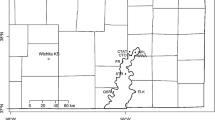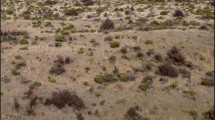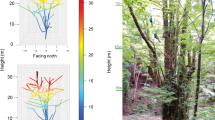Abstract
Key message
Maintenance of Carya in successional stands will require canopy disturbances larger than the gap-scale to increase understory light in conjunction with reduction in competition from shade-tolerant mesophytes.
Abstract
A widespread compositional shift has been reported in Quercus–Carya forests throughout the eastern USA. Quercus and Carya are failing to regenerate and understories of these stands are increasingly dominated by shade-tolerant mesophytes. Important in this successional shift are the canopy accession strategies and climate sensitivities of the dominant and projected replacement species. The goals of our study were to document establishment and canopy accession strategies and examine the relationships between climate variables and radial growth for Carya glabra, Carya ovata, and Carya alba. The majority (75 %) of Carya individuals established in open canopy conditions. However, 40 % of our samples experienced suppression before canopy accession. Average age at canopy accession for trees that were suppressed prior to canopy recruitment was 49 years. Carya that established in closed canopy conditions were suppressed an average of 22 years and were 2.6 cm diameter at breast height (dbh) before they ascended to the canopy or experienced a release episode. Gap origin-gap release trees were in open canopy conditions for an average of 18 years and were 6.5 cm dbh before experiencing a period of suppression. The three species exhibited similar responses to climate as they were generally sensitive to prior spring and current summer temperature, and prior winter and current summer precipitation, but radial growth trends were controlled more strongly by canopy position than climate. Maintenance of Carya in successional stands will require increases in understory light and reductions in competition from shade-tolerant mesophytes. Our results indicate that canopy disturbances larger than the gap-scale are needed for Carya establishment and canopy recruitment.





Similar content being viewed by others
References
Abrams MD (1992) Fire and the development of oak forests. Bioscience 42:346–353
Abrams MD, Orwig DA, Demeo TE (1995) Dendroecological analysis of successional dynamics for a presettlement-origin white pine-mixed oak forest in the southern Appalachians, USA. J Ecol 83:123–133
Baker FS (1949) A revised tolerance table. J For 47:179–181
Bazzaz FA (1979) The physiological ecology of plant succession. Annu Rev Ecol Syst 10:351–371
Biondi F (1997) Evolutionary and moving response functions in dendroclimatology. Dendrochronologia 15:139–150
Biondi F, Waikul K (2004) DENDROCLIM2002: a C++ program for statistical calibration of climate signals in tree-ring chronologies. Comput Geosci 30:303–311
Braun EL (1950) Eastern deciduous forests of North America. Blakiston, Philadelphia
Brokaw NVL (1985) Treefalls, regrowth, and community structure in tropical forests. In: Pickett STA, White PS (eds) The ecology of natural disturbance and patch dynamics. Academic Press, New York, pp 53–69
Brose PH, Dey DC, Phillips RJ, Waldrop TA (2013) A meta-analysis of the fire-oak hypothesis: does prescribed burning promote oak reproduction in eastern North America? For Sci 59:322–334
Buchanan ML, Hart JL (2012) Canopy disturbance history of old-growth Quercus alba sites in the eastern United States: examination of long-term trends and broad-scale patterns. For Ecol Manag 267:28–39
Canham CD (1985) Suppression and release during canopy recruitment in Acer saccharum. Bull Torrey Bot Club 112:134–145
Canham CD (1989) Different responses to gaps among shade-tolerant tree species. Ecology 70:548–550
Canham CD (1990) Suppression and release during canopy recruitment in Fagus grandifolia. Bull Torrey Bot Club 117:1–7
Cao KF, Ohkubo T (1999) Suppression and release during canopy recruitment in Fagus crenata and Acer mono in two old-growth beech forests in Japan. Plant Ecol 145:281–290
Clatterbuck WK, Smalley GW, Turner JA, Travis A (2006) Natural history and land use history of Cumberland Plateau forests in Tennessee. National Council for Air and Stream Improvement, Inc. Special Report No. 06-01: 37
Clinton BD, Boring LR, Swank WT (1993) Canopy gap characteristics and drought influences in oak forests of the Coweeta Basin. Ecology 74:1551–1558
Cook ER (1985) A time-series analysis approach to tree-ring standardization. Ph.D. Dissertation, University of Arizona, Tucson
Cook ER, Krusic PJ (2011) Software [online]. http://www.ldeo.columbia.edu/tree-ring-laboratory/resources/software
Copenheaver CA, Black BA, Stine MB, McManamay RH, Bartens J (2009) Identifying dendroecological growth releases in American beech, jack pine, and white oak: within-tree sampling strategy. For Ecol Manag 257:2235–2240
Copenheaver CA, Crawford CJ, Fearer TM (2011) Age-specific responses to climate identified in the growth of Quercus alba. Trees 25:647–653
Crow TR (1988) Reproductive mode and mechanisms for self-replacement of northern red oak (Quercus rubra): a review. For Sci 34:19–40
Daly C, Neilson RP, Phillips DL (1994) A statistical-topographic model for mapping climatological precipitation over mountainous terrain. J Appl Meteorol 33:140–158
Daly C, Gibson WP, Taylor GH, Johnson GL, Pasteris P (2002) A knowledge based approach to the statistical mapping of climate. Clim Res 22:99–113
Dey DC (2002) The ecological basis for oak silviculture in eastern North America. In: McShea WJ, Healy WM (eds) Oak forest ecosystems ecology and management for wildlife. The John Hopkins University Press, Baltimore
Ellsworth JW, McComb BC (2003) Potential effects of passenger pigeon flocks on the structure and composition of presettlement forests of eastern North America. Conserv Biol 17:1548–1558
Evans JP, Keen EM (2013) Regeneration failure in a remnant stand of pignut hickory (Carya glabra) on a protected barrier island in Georgia, USA. Nat Area J 33:171–176
Fei S, Kong N, Steiner KC, Moser WK, Steiner EB (2011) Change in oak abundance in the eastern Unites States from 1980 to 2008. For Ecol Manag 262:1370–1377
Fenneman NM (1938) Physiography of eastern United States. McGraw Hill, New York
Francis JK, Loftus NS (1977) Chemical and physical properties of Cumberland Plateau and Highland Rim forest soils. Southern Forest Experiment Station, New Orleans
Fraver S, White AS (2005) Identifying growth releases in dendrochronological studies of forest disturbance. Can J For Res 35:1648–1656
Fritts HC (1976) Tree rings and climate. Academic Press, New York
Goldblum D (2010) The geography of white oak’s (Quercus alba L.) response to climatic variables in North America and speculation on its sensitivity to climate change across its range. Dendrochronologia 28:73–83
Gottschalk KW (1983) Management strategies for successful regeneration: oak-hickory. In: Proceedings of 1983 Penn State forestry issues conference—regenerating hardwood stands. Pennsylvania State University, University Park, pp 190–213
Graney DL (1990) Carya ovata (Shagbark hickory). Silvics of North America. USDA Forest Service, Washington, DC
Grissino-Mayer HD (2001) Evaluating crossdating accuracy: a manual and tutorial for the computer program COFECHA. Tree-Ring Res 57:205–221
Hart JL, Grissino-Mayer HD (2008) Vegetation patterns and dendroecology of a mixed hardwood forest on the Cumberland Plateau: implications for stand development. For Ecol Manag 255:1960–1975
Hart JL, Grissino-Mayer HD (2009) Gap-scale disturbance processes in secondary stands on the Cumberland Plateau, Tennessee, USA. Plant Ecol 201:131–146
Hart JL, Clark SL, Torreano SJ, Buchanan ML (2012a) Composition, structure, and dendroecology of an old-growth Quercus forest on the tablelands of the Cumberland Plateau, USA. For Ecol Manag 266:11–24
Hart JL, Buchanan ML, Clark SL, Torreano SJ (2012b) Canopy accession strategies and climate-growth relationships in Acer rubrum. For Ecol Manag 282:124–132
Henry JD, Swan JMA (1974) Reconstructing forest history from live and dead plant material—an approach to the study of forest succession in southwest New Hampshire. Ecology 55:772–783
Hinkle CR (1989) Forest communities of the Cumberland Plateau of Tennessee. J Tenn Acad Sci 64:123–129
Hinkle CR, McComb WC, Safely JM, Schmalzer PA (1993) Mixed mesophytic forests. In: Martin WH, Boyce SG, Echternacht AC (eds) Biodiversity of the southeastern United States: upland terrestrial communities. John Wiley and Sons, New York, pp 203–253
Holmes RL (1983) Computer assisted quality control in tree-ring dating and measurement. Tree-Ring Bull 43:69–78
Hutchinson TF, Boerner REJ, Sutherland S, Sutherland EK, Ortt M, Iverson LR (2012) Prescribed fire effects on the herbaceous layer of mixed-oak forests. Can J For Res 35:877–890
Kariuki M (2002) Height estimation in complete stem analysis using annual radial growth measurements. Forestry 75:63–74
Kneeshaw DD, Kobe RK, Coates KD, Messier C (2006) Sampling size influences shade tolerance ranking among southern boreal tree species. J Ecol 94:471–480
Kozlowski TT (1971) Growth and development of trees: v. 1 Seed germination, ontogeny, and shoot growth. Academic Press, New York
Kozlowski TT, Pallardy SG (1997) Physiology of woody plants, 2nd edn. Academic Press, San Diego
Kricher J, Morrison G (1998) Eastern forests. Peterson field guide series. Houghton Mifflin Company, Boston
Latham RE (1992) Co-occurring tree species change rank in seedling performance with resources varied experimentally. Ecology 73:2129–2144
LeBlanc DC, Terrell MA (2009) Radial growth response of white oak to climate in eastern North America. Can J For Res 39:2180–2192
Lorimer CG (1984) Development of the red maple understory in northeastern oak forests. For Sci 301:3–22
Lorimer CG (1985) Methodological considerations in the analysis of forest disturbance history. Can J For Res 15:200–213
Lorimer CG (1993) Causes of the oak regeneration problem. In: Loftis D, McGee C (eds.) Oak regeneration: serious problems, practical recommendations, symposium proceedings, 8–10 September 1992, Knoxville, Tennessee. United States Department of Agriculture Forest Service, Southern Forest Experiment Station, Asheville, North Carolina, pp 14–39 (General Technical Report SE-84)
McCarthy BC (1994) Experimental studies of hickory recruitment in a wooded hedgerow and forest. Bull Torrey Bot Club 121:240–250
McCarthy BC, Wistendahl WA (1988) Hickory (Carya spp.) distribution and replacement in a second-growth oak hickory forest of southeastern Ohio. Am Midl Nat 119:156–164
McEwan RW, Dyer JM, Pederson N (2011) Multiple interacting ecosystem drivers: toward an encompassing hypothesis of oak forest dynamics across eastern North America. Ecography 34:234–256
Monk CD (1981) Age structure of Carya tomentosa (Poir.) Nutt. in a young oak forest. Am Midl Nat 106:189–191
Monk CD, Imm DW, Potter RL, Parker GG (1989) A classification of the deciduous forest of eastern North America. Vegetation 80:167–181
Monk CD, Imm DW, Potter RL (1990) Oak forests of eastern North America. Castanea 55:77–96
Myster RW, McCarthy BC (1989) Effects of herbivory and competition on survival of Carya tomentosa (Juglandaceae) seedlings. Oikos 56:145–148
Naidu SL, DeLucia EH (1997) Acclimation of shade-developed leaves on saplings exposed to late-season canopy gaps. Tree Physiol 17:367–376
NCDC (National Climate Data Center) (2013) Tornado climatology, NOAA. http://www.ncdc.noaa.gov/oa/climate/severeweather/tornadoes.html
Nelson TC (1965) Silvical characteristics of the commercial hickories. Hickory Task Force Report. Southeastern Forest Experiment Station
Niinemets Ü, Valladares F (2006) Tolerance to shade, drought, and waterlogging of temperate Northern Hemisphere trees and shrubs. Ecol Monogr 76:521–547
Nixon CM, McClain MW, Landes RK, Hansen LP, Sanderson HR (1983) Response of suppressed hickories to release cutting. Wildl Soc Bull 11:42–46
Nowacki GJ, Abrams MD (2008) The demise of fire and the ‘mesophication’ of forests in the eastern United States. Bioscience 58:123–138
Oliver CD, Larson BC (1996) Forest stand dynamics, update edn. McGraw-Hill Book Company, New York
Orvis KH, Grissino-Mayer HD (2002) Standardizing the reporting of abrasive papers used to surface tree-ring samples. Tree-Ring Res 58:47–50
Poulson TL, Platt WJ (1996) Replacement patterns of beech and sugar maple in Warren Woods, Michigan. Ecology 77:1234–1253
PRISM Climate Group, 2013. http://www.prism.oregonstate.edu/
Reinhardt ED, Keane RE, Brown JK (1997) First order fire effects model: FOFEM 4.0 User’s guide. USDA Forest Service, Intermountain Research Station, INT-GTR-344, Missoula, Montana
Rentch JS, Desta F, Miller GW (2002) Climate, canopy disturbance, and radial growth averaging in a second-growth mixed-oak forest in West Virginia, USA. Can J For Res 32:915–927
Rentch JS, Fajvan MA, Hicks RR (2003) Oak establishment and canopy accession strategies in five old-growth stands in the central hardwood forest region. For Ecol Manag 184:285–297
Richards JD, Hart JL (2011) Canopy gap dynamics and development patterns in secondary Quercus stands on the Cumberland Plateau, Alabama, USA. For Ecol Manag 262:2229–2239
Robison SA, McCarthy BC (1999) Growth responses of Carya ovata (Juglandaceae) seedlings to experimental sun patches. Am Midl Nat 141:69–84
Rubino DL, McCarthy BC (2004) Comparative analysis of dendroecological methods used to assess disturbance events. Dendrochronologia 21:97–115
Ruffner CM, Abrams MD (1998) Relating land-use history and climate to the dendroecology of a 326-year-old Quercus prinus talus slope forest. Can J For Res 28:347–358
Runkle JR (1985) Disturbance regimes in temperate forests. In: Pickett STA, White PS (eds) The ecology of natural disturbance and patch dynamics. Academic Press, San Diego
Runkle JR (1991) Gap dynamics of old-growth eastern forests: management implications. Nat Area J 11:19–25
Schweitzer CJ, Dey DC (2011) Forest structure, composition, and tree diversity response to a gradient of regeneration harvests in the mid-Cumberland Plateau escarpment region, USA. For Ecol Manag 262:1729–1741
Scurfield G (1973) Reaction wood: its structure and function. Science 179:647–655
Smalley GW (1982) Classification and evaluation of forest sites on the northern Cumberland Plateau. USDA, Forest Service, Southern Research Experiment Station, GTR SO-38, New Orleans, Louisiana
Smalley GW (1986) Classification and evaluation of forest sites on the northern Cumberland Plateau. USDA, Forest Service, Southern Research Experiment Station, GTR SO-60, New Orleans, Louisiana
Smalley GW (1990) Carya glabra (Sweet pignut hickory). Silvics of North America. USDA Forest Service, Washington, DC
Smalley GW (1991) Classification and evaluation of forest sites on the Natchez Trace State Forest, State Resort Park, and wildlife management area in West Tennessee. General Technical Report SO-85, USDA Forest Service, Southern Forest Experiment Station, New Orleans, Louisiana
Smith HC (1990) Carya tomentosa (Mockernut hickory). Silvics of North America. USDA Forest Service, Washington, DC
Sork VL (1983) Distribution of pignut hickory (Carya glabra) along a forest to edge transect, and factors affecting seedling recruitment. Bull Torrey Bot Club 110:494–506
Speer JH, Grissino-Mayer HD, Orvis KH, Greenberg CH (2009) Climate response of five oak species in the eastern deciduous forest of the southern Appalachian Mountains, USA. Can J For Res 39:507–518
Stokes MA, Smiley TL (1996) An Introduction to tree-ring dating. University of Arizona Press, Tucson
Stringer JW, Kimmerer TW, Overstreet JC, Dunn JP (1989) Oak mortality in eastern Kentucky. South J Appl For 13:86–91
Stueve KM, Perry CH, Nelson MD, Healey SP, Hill AD, Moisen GG, Cohen WB, Gormanson DD, Huang C (2011) Ecological importance of intermediate windstorms rivals large, infrequent disturbances in the northern Great Lakes. Ecosphere 2:1–21
Thornthwaite CW (1948) An approach toward a rational classification of climate. Geogr Rev 38:55–94
Trimble GR (1975) Summaries of some silvical characteristics of several Appalachian hardwood trees. USDA Forest Service General Technical Report, Northeastern Forest Experiment Station NE-16
U.S. Global Change Research Program (2009) Global climate change impacts in the United States. In: Karl TR, Melillo JM, Peterson TC (eds.) Cambridge University Press, Cambridge
USDA (1995) Soil survey of Fentress and Pickett Counties, Tennessee. USDA Soil Conservation Service, Washington, DC
Watt RF, Brinkman KA, Roach BA (1973) Oak-Hickory. In: Silvicultural systems for the major forest types of the United States, vol 445, pp 66–69
White PB, Van de Gevel SL, Grissino-Mayer HD, LaForest LB (2011) Climatic response of oak species across an environmental gradient in the southern Appalachian Mountains, USA. Tree-Ring Res 67:27–37
Yamaguchi DK (1991) A simple method for cross-dating increment cores from living trees. Can J For Res 21:414–416
Ziaco E, Biondi F, Di Filippo A, Piovesan G (2012) Biogeoclimatic influences on tree growth releases identified by the boundary line method in beech (Fagus sylvatica L.) populations of southern Europe. For Ecol Mang 286:28–37
Acknowledgments
Field data collection was funded by the NSF under grants BCS-0602445 and DGE-0538420. We thank Ryan Foster, Sara Hart, Kevin Horn, Chris Underwood, and Saskia van de Gevel for assistance in the field; Michael Dewar and Matt McConnell for assistance in the lab; and The Nature Conservancy and the Tennessee Department of Environment and Conservation for sampling permission. We thank Grant Harley for helpful discussion on climate-growth analysis. We are also grateful for the comments provided by Shawn Fraver, Brian McCarthy, Gianluca Piovesan, and an anonymous reviewer that greatly improved the manuscript.
Conflict of interest
The authors declare that they have no conflict of interest.
Author information
Authors and Affiliations
Corresponding author
Additional information
Communicated by G. Piovesan.
Rights and permissions
About this article
Cite this article
Cowden, M.M., Hart, J.L. & Buchanan, M.L. Canopy accession strategies and climate responses for three Carya species common in the Eastern Deciduous Forest. Trees 28, 223–235 (2014). https://doi.org/10.1007/s00468-013-0944-3
Received:
Revised:
Accepted:
Published:
Issue Date:
DOI: https://doi.org/10.1007/s00468-013-0944-3




